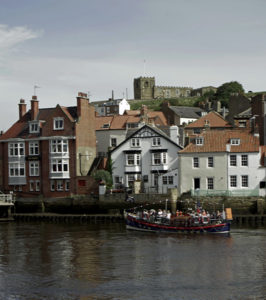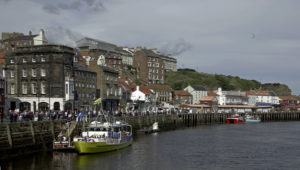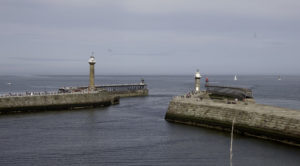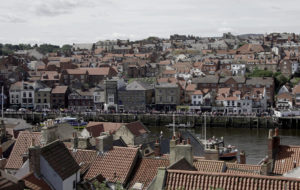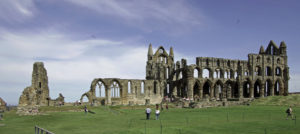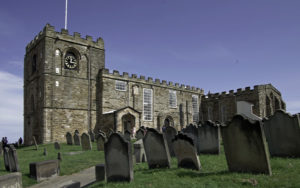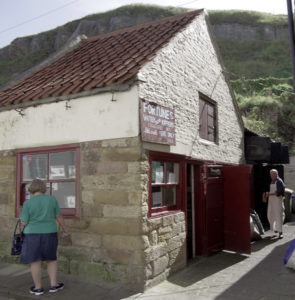With Dracula, Captain Cook, Whitby Jet and fish and chips, Whitby has something for everyone as well as narrow cobbled streets to explore and the iconic 199 steps.
It is an attractive settlement nestled along the mouth of the River Esk with the remains of the abbey and the even older St Mary’s Church set high above the east cliff. These were what inspired Bram Stoker to write his Gothic Novel ‘Dracula’. The Goth culture still survives with the “Dracula Experience”:http://draculaexperience.co.uk/ and the popular twice yearly “Goth Weekend.”:http://www.whitbygothweekend.co.uk/
The headland has been settled since the Bronze Age. There was a Roman Signal Station here in the C3rd, which has since fallen into the sea. By the C7th Whitby was part of the powerful kingdom of Northumbria with an important monastic settlement on the East Cliff. Many Northumbrian kings were buried here. Caedmon, the first English poet was based at Whitby Abbey and is commemorated by a modern Anglian style cross in the graveyard of St Mary’s Church.
Although no visible remains of this can be seen, geophysical surveys indicate there are still substantial buried remains. There are displays of artefacts in the exhibition at “Whitby Abbey.”:http://wasleys.org.uk/eleanor/churches/england/ruined_abbeys/north/whitby/index.html
The town suffered badly in Danish raids in the C9th. The monastic site on the East Cliff was abandoned although the fishing settlement and thriving port around the mouth of the River Esk survived. A new “abbey church”:http://wasleys.org.uk/eleanor/churches/england/ruined_abbeys/north/whitby/whitby_one/index.html was built after the Norman Conquest and the ruins of this along with “St Mary’s Church”:http://wasleys.org.uk/eleanor/churches/england/yorkshire/north_yorkshire/north_yorkshire_three/whitby/index.html silhouetted against the sky, dominate the East Cliff. These are still reached by the 199 steps which were used to carry coffins to the graveyard round the church.
Whitby was a thriving port in the C18th with an important fishing and whaling fleet. Alum and ironstone mined locally was also exported from here. It had shipyards, rope makers and sail yards. James Cook worked here as a merchant navy apprentice with John and Henry Walker, before volunteering for the Royal Navy. He learnt his cartography and surveying skills with them. All his ships used in his explorations of Australia and New Zealand were built in Whitby. The “Captain Cook Museum”:http://www.cookmuseumwhitby.co.uk/ in Grape Lane is in the house belonging to John Walker. It is a good example of a comfortable home belonging to a prosperous ship owner. The ground floor rooms have been furnished using an inventory from the early 1750s. The upstairs rooms contain an exhibition about Cook’s life and voyages. There are letters from James Cook, maps and charts as well as paintings and drawings by artists accompanying on his voyages.
A fishing fleet still sails out of Whitby and no trip to Whitby is complete without fish and chips. There is plenty of choice at a variety of prices. The “Magpie Cafe”:http://www.silvertraveladvisor.com/review/restaurant/147827-review-the-magpie-cafe on the west side of the harbour is very well known but is expensive. We ate in the “Monk’s Haven Tea Room”:http://www.silvertraveladvisor.com/review/restaurant/162555-review-monks-haven-cafe which was a lot cheaper with huge helpings of fish and chips served with bread and butter.
“Fortunes Kippers”:http://www.silvertraveladvisor.com/review/attraction/162335-review-fortunes-kippers on Henrietta Street, below the abbey ruins have been smoking kippers on the same site for nearly 150 years. My father remembered visits to them on boyhood visits to Whitby, nearly a hundred years ago. There is a steady stream of customers attracted by the appetising smells coming from the tiny smokery. The shop hasn’t changed either with its green tiled walls and kippers still wrapped up in newspaper. They are completely different to the mass produced supermarket kippers. It is worth visiting Whitby just for them.
The West Cliff in Whitby became a major tourist attraction in the C19th with its sandy beach and hotels. The whalebone arch erected in 1853 is a reminder of Whitby’s whaling days. Whale jaw bones were attached to the mast of returning whaling ships to indicate a successful catch. Near it is a statue of James Cook. Winding paths drop down the cliff to the beach but in summer there is a “cliff lift,”:https://www.discoveryorkshirecoast.com/discover/things-to-do/cliff-lift-whitby-p1282901 an innovative idea after proposals for a funicular railway were turned down. The “Spa Pavillion”:http://www.whitbypavilion.co.uk/ hosts dances, shows and exhibitions. There is pitch and putt, crazy golf , bumper boats and a leisure centre.
Fishing charters are run from the harbour as well as trips in the “old lifeboat”:http://www.oldlifeboatwhitby.co.uk/ .
A replica of “Captain Cook’s Bark Endeavour”:http://www.endeavourwhitby.com/ takes visitors along the coast to Sandsend.
For those preferring dry land, the “open top bus”:http://www.coastalandcountry.co.uk/openTopCoach.html provides guided tours around the town, allowing visitors to hop on and off as much as they like.
The “Whitby Museum”:http://www.whitbymuseum.org.uk/ in Pannett Park also has information about Captain Cook as well as collections of fossils (the rocks are famous for their ammonite fossils), archaeology, social history and paintings. The park with its colourful displays of flowers is an attractive place to drop out away from the bustle of Whitby.
And finally there is Whitby Jet, an unusual souvenir. This is actually fossilised wood form jurassic times which washed out of the cliffs and can be collected on the beach. Deep black in colour and taking a high polish this has been made into jewellery for over 200 years. Queen Victoria made it popular as Whitby jet was the only ornament she wore when in mourning. it is still carved and made into jewellery with many shops selling it.
Whitby has been a popular tourist destination for over 150 years and still draws in the crowds. Most come by car but some still arrive by train at the splendid station built at the start of the tourist boom. It is still possible to arrive here by steam train from Grosmont, on the “North York Moors Railway.”:http://www.nymr.co.uk/
It makes an excellent day out, or the base for a longer traditional sea side holiday. Even on a cold, wet blustery day in February there is still plenty to do. Go and find out for yourselves.
